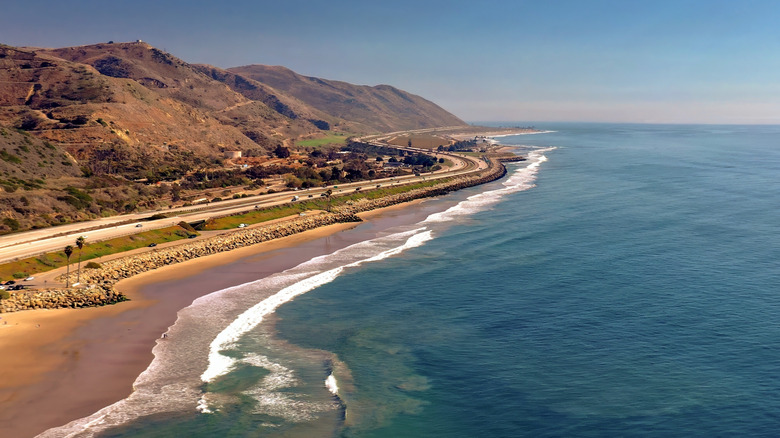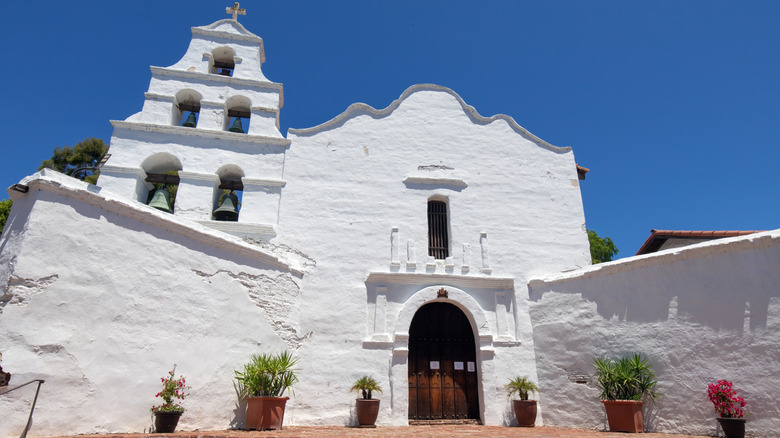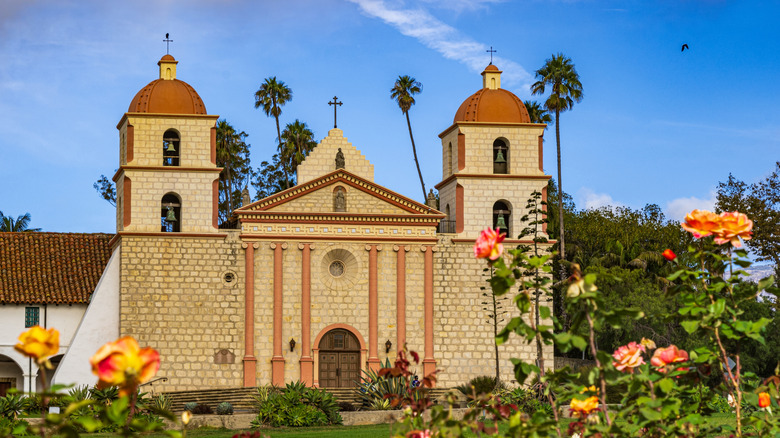Stretching Between San Diego And Sonoma, This Scenic Trail Is A Road Trip Through California History
Highway 101 is a famed stretch of roadway, known as California's striking coastal road trip route through the state's best beaches and quaint cities. And though it's immortalized in today's zeitgeist by viral Instagram shots and a lyric in Phantom Planet's song "California," the highway has a much longer legacy than you may realize. In fact, it's part of a famous trail that connects some of California's most remarkable monuments. California's Historic Missions Trail follows the El Camino Real, the former road which connected 21 Spanish colonial missions that were constructed between the mid-18th century to the early 19th century. Today's Highway 101 closely follows the trail, marked by historic bells all along the way.
The nearly 800-mile Missions Trail runs alongside stretches of Interstate 5, Highway 82, Highway 37, and, of course, Highway 101. Volunteers working with the trail are trying to re-establish the historic walking path to make hiking from mission to mission a reality, much like it originally was in the 19th century. While the hiking trail is still a ways off from coming to fruition, driving the modern version of the trail via the aforementioned highways is currently the most viable way of seeing the missions. From San Diego, home to stunning beaches, to Sonoma, a top California wine region, a number of towns on this north-south stretch of the state boast a historic mission. Several of the original 21 missions still stand, and they are visitable as museums and/or operated as Catholic parishes to this day. Others are in ruins, lost to neglect, weather, or the environment. Most, however, mark how Indigenous settlement, Spanish colonialism, and American exploration intersected at these historical centers of religion, commerce, and politics.
What you need to know about tackling the Missions Trail
As hiking is still not entirely established, be prepared to drive from site to site along the Missions Trail. Begin your adventure at the very first mission established, Mission San Diego de Alcala. Founded in 1769 by Father Junipero Serra, the mission was established as a religious conversion center, agricultural base, and military outpost. Spurred on by religious zeal and colonial conquest, the mission at San Diego served as the blueprint for the ensuing 20 missions and today is operated by the Catholic church. It's known for its beautiful bougainvillea blooms, one of California's first cemeteries, and its stunning lush gardens.
The next geographically proximate mission is Mission San Luis Rey located in Oceanside, the 18th mission to be established. Not all missions were founded along the coast in chronological order, thus you may be traveling through time visiting the missions geographically from south to north or vice versa. If you want to stick to one mission per county, however, proceed onwards towards Mission San Juan Capistrano, Orange County's only mission. The subsequent missions on the trail are located some 30 miles apart. Towns with a mission include Mission Hills, Ventura, Solvang, and Sonoma. Standouts to visit include Mission San Francisco de Asis in the heart of the city; Mission Santa Barbara known as the "Queen of the Missions"; and Mission San Luis Obispo de Tolosa, one of the best-restored buildings on the trail.
What you should expect to see at the California missions
Each mission has its own essence, differing from locale to locale to match the environment and surroundings of the structure. Some missions, like the aforementioned San Luis Obispo de Tolosa, feature unique architectural details like the first tiled roof of all the sites. Many of the missions that are still standing also reflect local history. Mission Santa Barbara, for example, was largely damaged during the historic earthquakes that hit the area in 1925. However, its facade remained standing, and from this architectural cue, the city rebuilt in a unified Spanish Colonial Revival style that's seen predominantly around Santa Barbara today and gives it the moniker "The American Riviera." Architecture aside, each mission features its own blend of gardens, liturgical art, and tribal histories. Various missions relay histories of Spanish colonialism in their respective areas, discussing relationships with Indigenous Peoples, what life was like in rural California during that time period, and how agriculture operated in the regions.
Bear in mind that many missions are no longer standing, but their ruins are still visitable. Others have fully restored or well-maintained structures. Mission San Jose, for instance, founded in 1797 as the 14th mission, underwent a $5 million remodel that crafted an impressive reproduction of its 1809 church. The original church no longer stands, but now, the mission has come back to life in a way that allows the modern public to engage with it. This just points to the spirit of the Missions Trail and Highway 101 — it presents California history in authentic ways, even if the original sites are no longer there.


